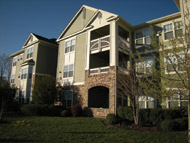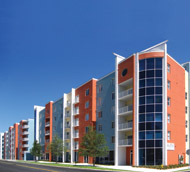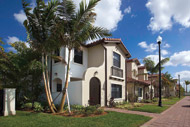|
COVER STORY, SEPTEMBER 2012
TURNING UP THE VOLUME
Multifamily sales continue to gain momentum in the Southeast.
Savannah Duncan
Investors continue to show interest in the Southeast, due to several strong apartment markets and a growing population. Sales are up on a year-over-year basis, and financing is readily available. Class A assets in core markets and value-add properties are experiencing the most activity.
“From 2008 to 2010, it was very difficult to transact a multifamily deal, especially a large one,” says Gene Berman, executive vice president and managing director of Marcus & Millichap’s Fort Lauderdale, Florida, office. “Now, it has become the darling of the [commercial real estate] market.”
Trends In The Market
Multifamily transaction volume in the Southeast in the second quarter of 2012 was $3.7 billion, up from $2.8 billion in the second quarter of 2011, according to Real Capital Analytics.
Year-to-date, Atlanta-based ARA has closed 221 transactions nationwide, including 17 multifamily deals representing approximately $205 million in Atlanta. “Last year at this time, we had closed 11 transactions totaling $96 million,” says Sean Henry, partner of ARA’s Atlanta office. “Our volume is up quite a bit and that’s reflective of what’s going on in the market.”
Marcus & Millichap has also experienced an uptick in activity. Berman says that the company has closed nearly 185 multifamily sales nationwide year-to-date, a growth of 15 percent compared to this time last year.
 |
In April, Southeast Apartment Partners arranged the $55.1 million sale of the 374-unit Empirian Chesapeake located in Chesapeake, Virginia. |
|
While multifamily sales may have been a struggle a few years ago, the sales of high-quality assets are relatively smooth today, says Marc Robinson, managing director of Southeast Apartment Partners’ Atlanta office. “When you get into Class B and C assets, transactions aren’t as smooth. Financing is still a challenge for Class B and C space,” he says.
Financing for Class A space, on the other hand, is increasingly easy to procure. Though lenders are requiring a more in-depth due diligence process, Henry says they are ready, willing and able to provide financing for multifamily transactions.
“Money is available, and not only from Fannie Mae and Freddie Mac,” he adds. “Agency debt has been available throughout the downtown, but now life companies are coming back into the game. We’re noting some CMBS activity and bank loans are becoming popular.”
Falling capitalization rates also demonstrate a continued strengthening of the multifamily market. In the second quarter, capitalization rates averaged 6.7 percent, compared to 7.1 percent in the second quarter of 2011, according to Real Capital Analytics.
“No one thought the efficiencies of the market would get to what occurred in the 2005 and 2006 marketplace with the compression of cap rates, but that’s happening again,” Berman says.
High-quality properties are trading at a low four percent capitalization rate, Henry says, and go up to six to seven percent, depending on the quality of the investment. For value-add properties, Robinson says the capitalization rates are between seven and nine percent.
Who’s Buying?
Highly desirable markets throughout the Southeast are attracting many different kinds of buyers. Berman says wealthy partnerships and high-net-worth individuals are competing more aggressively than ever with institutional buyers.
“Investors are attracted to core assets and high-quality value-add assets,” Robinson says. Cities like Atlanta; Nashville, Tennessee; Raleigh-
Durham and Charlotte, North Carolina, are of interest to buyers due to their strong underlying fundamentals. In addition to location, Robinson says buyers typically take into account the age of the property, local demographics and quality of the asset.
 |
Bell Partners acquired the 422-unit Bell Channelside in Tampa,
formerly known as Seaport Channelside Apartments, for $66 million in April. |
|
Bell Partners has acquired four high-quality multifamily properties throughout the Southeast since March, including the 131-unit Bell Miramar in Miramar, Florida, for $30 million; the 422-unit Bell Channelside in Tampa, Florida, for $66 million; the 214-unit Bell Morrison in Charlotte for $33.3 million; and the 269-unit Bell Hartsfield in Atlanta for $33.6 million.
“Each has a unique location near major employment and transportation nodes and all are situated without our specific targeted markets,” says Jon Bell, president of Bell Partners, based in the firm’s Greensboro, North Carolina, office. “We generally seek to acquire Class B-plus to A properties in A locations.”
The private real estate investment company’s portfolio currently includes 68,822 units in 247 properties. Approximately 75 percent of its portfolio is located in the Southeast.
 |
In June, Bell Partners purchased the 131-unit Bell Miramar in Miramar, Florida, for $30 million. The property was formerly known as Treo Apartments. |
|
On the value-add side, companies such as Advenir and BPG Properties have been acquiring well-located assets throughout the Southeast as well.
In May, BPG purchased the 200-unit Greens at Falls Run and the 476-unit Manor at England Run, both located in Fredericksburg, Virginia, for $83.4 million. It was the first multifamily acquisition that BPG made on behalf of BPG Investment Partnership IX, its newly formed, $250 million value-add real estate fund. The firm owns 19,000 units, approximately one-third of which are located in the Southeast.
“We like the dynamics of that community and the way it has grown dramatically over the last decade,” says Joe Mullen, director of multifamily investments for BPG, based in the firm’s Philadelphia office. “It was an off-market transaction, so we dealt directly with the seller. We like deals where we can do a direct transaction.”
Upon purchasing a value-add property, BPG will decide what actions need to be taken in order to raise the quality of the property. Sometimes, the company will invest $5,000 to $15,000 per unit on interior upgrades, Mullen says. “It depends on where you think you can get your rents to in order to justify those upgrades.”
Advenir, a real estate investment company, has also been active in the Southeast market. The company’s portfolio includes 6,000 multifamily units in Florida, North Carolina, Colorado and Texas, with 2,100 units located in the Southeast. In July, Advenir purchased the 308-unit Advenir at Polos East in Waterford Lakes, Florida, a submarket of Orlando, for $27.1 million.
“We were attracted to the property because of its significant value to replacement cost, strong market fundamentals and clear value-add potential,” says Todd Linden, chief acquisition officer of Aventura, Florida-based Advenir.
The Southeast is high on the company’s radar. Advenir focuses on garden-style communities in primary markets with high barriers to entry, immigration, job growth and low state income tax. Top markets for the company include Southeast Florida, Orlando, Tampa, Raleigh, Charlotte and Charleston, South Carolina. “In the past year, the company has acquired more than 2,300 multifamily units,” Linden adds. “We plan to add another 2,000 plus units in the next 12 months, with $60 million in equity to deploy.”
Hitting The Half-Way Point
While indicators look good that transaction volume will continue at a stable pace for the remainder of the year, Henry says during the past two years, the market has experienced a slowdown in the final two quarters.
“The good news for the apartment business is that those factors are not directly related to demand factors created by a lack of new development,” he says. “New development has scaled back and not kept up with population growth and household formation. This shortage has created very strong fundamentals for our business.”
Berman, however, is not concerned because of the large amount of equity on the sidelines looking to fuel good deals. “People see the multifamily marketplace as the safe haven for their investment dollars,” he says.
“We wait to see where an opportunity takes us,” Mullen echoes. “If it’s a good opportunity, we’ll make the investment and deploy the capital. We’d like to continue to make investments as opportunities arise.”
©2012 France Publications, Inc. Duplication
or reproduction of this article not permitted without authorization
from France Publications, Inc. For information on reprints
of this article contact Barbara
Sherer at (630) 554-6054.
|
